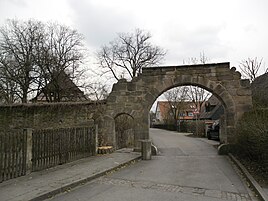Pillenreuth (Nuremberg)
|
Pillenreuth
City of Nuremberg
Coordinates: 49 ° 21 ′ 50 ″ N , 11 ° 4 ′ 32 ″ E
|
|
|---|---|
| Height : | approx. 325 m above sea level NHN |
| Residents : | 1377 (May 25 1987) |
| Postal code : | 90455 |
| Area code : | 0911 |
|
Western gate to the former monastery grounds
|
|
Pillenreuth is a district of the Middle Franconian city of Nuremberg . It belongs to the statistical district 491 Eibacher Forst ( Königshof ), which is part of the statistical district 49 ( Kornburg, Worzeldorf ).
location
The district is exactly 7 kilometers south of the city center. The Main-Danube Canal to the west and the Ludwig-Danube-Main Canal to the east are each one kilometer away . To the north, Pillenreuth is surrounded by flat forests that are exclusively home to pine monocultures from the Nuremberg Reich Forest . A stream flows south, the Eichenwaldgraben , otherwise the district has now merged with Weiherhaus (Nuremberg) .
history
Around 1300 Pillenreuth was first mentioned in the Nuremberg Reichssalbüchlein . Pillenreuth has been managed as an Aussiedelhof for an unknown time. A first documentary mention is known from 1345, when an additional donation was made to found the Pillenreuth monastery . The monastery had a long history and, along with farm buildings, stables and two ponds used for fishing, remained the only property in situ until the middle of the 18th century . It was not until 1863, when the Ludwig Canal went into operation, that a certain revival set in. The Meßthaler family bought the abandoned monastery and converted it into an inn. In the turmoil of the First and Second World War, the cultivation of the surrounding lands was gradually given up. The freed land was gradually built on by citizens relocating from the steadily growing Nuremberg from the post-war period. In 1950 there were 14 properties with 81 residents in Pillenreuth. The Meßthaler inn moved to a new building in Weiherhaus on the thoroughfare.
The buildings in the historic town center then passed into other hands, the restaurant Im Klösterle , the stud farm, the ponds and parts of the fortification walls were preserved, but were not extended or converted in accordance with the building boom of the 1960s and 70s. Pillenreuth developed into a purely residential area; there is no business and there are no shops in the district.
At the beginning of the 2010s, the business of the restaurant was no longer profitable after hygienic complaints and a changed consumer awareness of day trippers and local residents. Pillenreuth achieved a sad popularity when the landlady, with the intention of regaining a foothold economically with the sum insured, incited the cook to cause a gas explosion during the restaurant's company holiday, which he succeeded in doing. As a result, the landlady was sentenced to 6 1/2 years in prison in 2012, the cook to 2 1/2 years for aiding and abetting. The riding stables were also affected by the explosion. The remaining historical building fabric has so far only been temporarily secured and is currently only in ruins.
traffic
Close to Pillenreuth, the road N 1 provides access to the port of Nuremberg and the Autobahn 73 at a distance of two kilometers . There is also a stop on demand on the N 1, which Pillenreuth clocks in public transport .
literature
- Johann Kaspar Bundschuh : Pillenreuth . In: Geographical Statistical-Topographical Lexicon of Franconia . tape 4 : Ni-R . Verlag der Stettinische Buchhandlung, Ulm 1801, DNB 790364301 , OCLC 833753101 , Sp. 353 ( digitized version ).
- Johann Kaspar Bundschuh : Wildenreut, Bildenreut, Pillenreut . In: Geographical Statistical-Topographical Lexicon of Franconia . tape 6 : V-Z . Verlag der Stettinische Buchhandlung, Ulm 1804, DNB 790364328 , OCLC 833753116 , Sp. 238 ( digitized version ).
- Pleikard Joseph Stumpf : Pillenreuth . In: Bavaria: a geographical-statistical-historical handbook of the kingdom; for the Bavarian people . Second part. Munich 1853, p. 761-762 ( digitized version ).
Web links
Individual evidence
- ↑ bavarikon: Pillenreuth
- ↑ Pillenreuth in the BayernAtlas
- ↑ Michael Diefenbacher, Rudolf Endres (ed.): Stadtlexikon Nürnberg . 2nd improved edition. W. Tümmels Verlag, Nuremberg 2000, ISBN 3-921590-69-8 , p. 826 f .
- ^ History of the Pillenreuth Monastery in the Middle Ages
- ↑ History of the Pillenreuth monastery up to "Zum Klösterle"
- ↑ Nürnberg-aha, paragraph on Pillenreuth
- ↑ Photos from Pillenreuth on a private website
- ↑ Pillenreuth riding stable
- ↑ Press report on the gas explosion
- ↑ final press report on the condemnation with photo series



